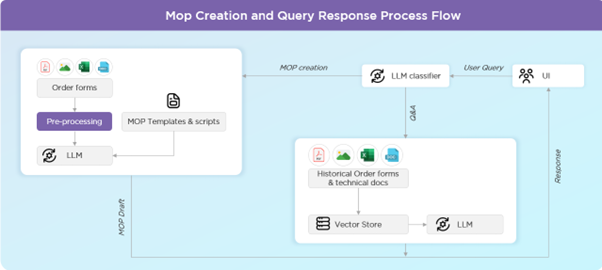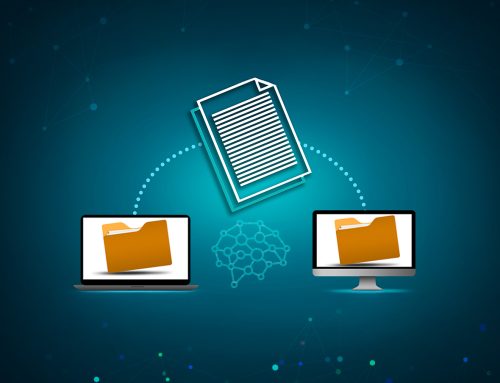Overview
In modern telecom operations, customer expectations for agility and precision are higher than ever. The change management team plays a critical role in managing remote configuration changes requested by enterprise clients. These changes typically include Port Regrades and Quality of Service (QoS) & Configuration Adjustments, which are essential for optimizing network performance and adapting to evolving business needs.
Each change request begins with a customer-submitted order form, which serves as the foundation for a series of technical validations. These validations ensure that the requested changes are feasible within the existing network infrastructure and inventory. Once validated, the team updates the inventory and prepares a Method of Procedure (MoP) document.
Let’s breakdown to further understand how a MoP document is developed.
- The process begins with the order form, which captures the customer’s requirements. The Soft Change Team then performs a thorough inventory check to confirm hardware availability and capacity. This is followed by inventory updates and a network technical validation, where engineers assess the impact and feasibility of the requested change.
- Once the change is deemed viable, the team moves on to MoP creation. This document includes step-by-step instructions, rollback plans, and post-change validation procedures. It also outlines the agreed-upon maintenance window, during which the change will be executed with minimal disruption to the customer’s services.
- After coordinating with the customer and scheduling the change, the team executes the MoP, monitors the network for stability, and confirms successful implementation. The process concludes with documentation updates and closure of the change request ticket.
Operational Bottlenecks in Change Management
Despite its structured approach, the current process faces several operational hurdles. One of the significant challenges is the manual intervention required to populate MoP templates. Engineers must enter technical details manually, which is not only time-consuming but also prone to human error. This error has the potential to affect customer service quality and may result in escalations.
Another bottleneck arises during the validation phase, where engineers must consult multiple documents, ranging from network topology maps to service records, to resolve technical queries. This fragmented information landscape slows down decision-making and complicates the validation process.
These challenges highlight the need for automation and centralized data access to reduce turnaround times and improve service delivery.
Accelerating MoP Creation with AI-Driven Automation
Telecom engineers can now respond faster to service change requests using Generative AI assisted system. TCTS has developed a MOP generator to reduce manual effort and improve accuracy by transforming raw inputs into validated, ready to execute MOPs.
Gains from the MoP generator
The MoP Generator is designed to transform the traditionally manual and time-consuming process of Method of Procedure creation into a streamlined, intelligent workflow. Communication Service Providers that use our automated solution have experienced the following benefits
- Eliminate Manual Efforts
By automating the retrieval and population of MoP templates, the generator significantly reduces the need for manual data entry. Engineers no longer have to spend hours filling out repetitive technical fields, allowing them to focus on higher-value tasks. - Intelligent Query Response
Integrated with a AI-based chatbot, the MoP Generator provides instant answers to technical queries. Whether it’s compatibility checks, historical config data, or validation rules, engineers can get accurate responses without digging through multiple documents. - Early Delivery and Billing
Faster MoP preparation leads to quicker execution of customer change requests. This not only improves service delivery timelines but also accelerates billing cycles, positively impacting revenue realization and customer satisfaction. - Improved Quality
Standardized templates, automated validations, and intelligent assistance ensure that every MoP is accurate, complete, and compliant with operational standards. This reduces the risk of errors during implementation and enhances overall service reliability.
|
MoP Generator in Action: Real-World Impact for a Leading European Telecom Provider A major communication provider in Europe recently implemented the MoP Generator to streamline their remote change request operations. The results have been transformative, both operationally and financially.
|
Why TCTS MoP Generator Stands Apart
Our MoP Generator is not just a document automation tool—it’s a smart, integrated system designed to simplify, accelerate, and enhance the entire Method of Procedure lifecycle.
- Dynamic MoP Generation with Customer Context
The generator creates an updated MoP base by intelligently combining customer-specific inputs from order forms and pre-existing repository documents and templates to ensure each MoP is tailored, accurate, and aligned with both customer requirements and internal standards. - LLM-Powered Preprocessing
Using Large Language Models (LLMs), the system preprocesses both the MoP and associated script templates based on user input, allowing for:- Keyword Extraction (Text + Image)
- Context-aware field population
- Smart formatting and structuring
- Reduction in manual editing time
This brings in flexibility and intelligence to the document creation process, adapting to different change types and customer scenarios.
- Natural Language Chatbot Assistance
A built-in chatbot or virtual assistant allows engineers to interact with the system in a conversational, personalized manner. It can:- Answer technical queries
- Provide document references
- Suggest best practices
This reduces the need to search through multiple systems and speeds up decision-making.
- Outlook Integration for Seamless Communication
The MoP Generator is integrated with Microsoft Outlook, enabling:- Automated email notifications for each activity (e.g., MoP ready, change scheduled, validation complete)
- Easy coordination with customers and internal teams
- Audit-friendly communication logs
The AI-powered MoP Generator transforms a traditionally manual process into a streamlined, intelligent workflow. By automating MoP creation, enhancing validation accuracy, and enabling faster service delivery, it empowers engineering teams to focus on more value-driven tasks while improving customer satisfaction.






